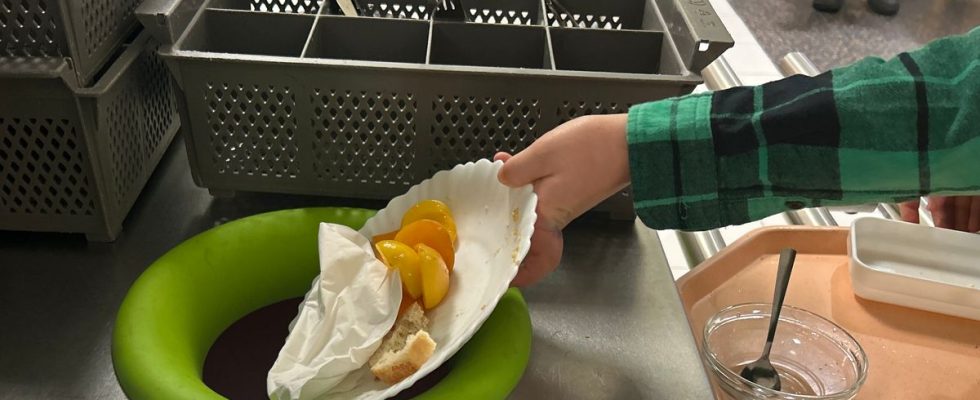“If everyone did like us, it would help the planet get better,” assures Pauline, in CM2 at the Chapeau Rouge school in the 9th arrondissement of Lyon. Waste collection, sorting, vegetable gardening, composting, reduction of food waste… The young schoolgirl proudly cites the “new ways” she has learned to “preserve the environment”. Like 70% of the city’s schools, his school has set up a collection of bio-waste so that it can be recycled.
“We put our napkin on the plate with what we haven’t eaten and pour it into the green bin,” shows the young girl. That lunchtime, on the occasion of European Waste Reduction Week, the students showed the press how they had been participating in this action for a year. The green bin is for food scraps and compostable paper towels, and the gray bin is for other waste.
“This market is an important step in our strategy aimed at making Lyon a zero waste territory,” underlines Camille Augey, deputy mayor responsible for employment and the sustainable economy. “It is also part of the city’s educational project which aims to promote education for ecological transition,” adds Stéphanie Leger, education assistant.
“We see that the children want to do more”
During the lunch break, the children are then accompanied so that they can “take more pleasure in eating” and “understand what is behind this food”, adds Adélaïde Larzillière, sustainable food mission manager at the city of Lyon. “The educational approach is central for them to become eco-citizens,” she emphasizes.
So that they are actors and responsible, children are then involved and informed. “We have to sort our leftovers well so that they can become compost for the farm,” explains Naoufel, in CM2. This 10-year-old child finds it “cool” and “satisfying” to participate in these actions for the environment. “It allows us to be aware of our actions,” he says. An opinion shared by Clémence Vanbrabant, CP teacher. “They are made aware of all these issues very early on. The fact that they are really involved has a big impact. We see that they want to do more and that they like it. »
150 grams end up in the trash
And it is not only through collection that the Chapeau Rouge school wishes to move towards less waste. “Now, for a snack, we make a cake at home or we bring some fruit,” explains Célia, also in CM2. “At lunchtime, if we don’t open something packaged, we bring it back and it doesn’t get thrown away,” Milo continues. Pauline continues: “There is also a buffet for starters, desserts and cheeses so that you can help yourself. We can take what we want and the quantity that suits us. But the instruction is to eat everything you have taken. »
For the main course too, the rule was “to adapt to the child’s appetite”, indicates the manager of the school restaurant Catherine Merlin. On average, per plate, 150 grams of food scraps end up in the trash for a meal of around 450 grams.
Meal quality and over-ordering
Despite all their good will, children remain… children. “It’s difficult to finish everything every day,” confides Maïa. But sometimes we challenge each other so that there is nothing left on our plate. »
“The zero waste objective in the canteen also includes the quality of meals,” says Adélaïde Larzillière. She specifies that satisfaction surveys are carried out daily in this regard. She reminds us that parents also have a role to play in the fight against food waste. Not to mention the continuity of simple gestures at home, it calls for vigilance when ordering meals.
“We work a lot to adjust as closely as possible with the central kitchen so that there is no waste in production,” she explains. Parents should also remember, for their part, to cancel the order if their child is absent. Over-ordering is one of the main sources of waste. » The city would like to achieve a gap of 4% between meals ordered and those not consumed. Last year it was 5%.

